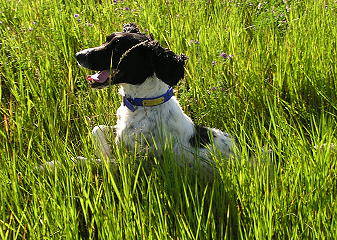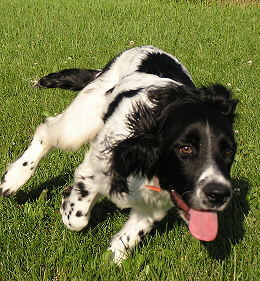  Ahoy-hoy ladies and gentleman. I sincerely hope you all are having a
wonderful summer. Actually, here in Wisconsin we have been having a
wonderful fall for most of July and August. While many are complaining about
the cool weather, those of us who train dogs are on cloud nine. We have
been very busy here. I almost put off writing this as daylight is not
too far away and it has been a long day. But I got some encouragement from a
good friend tonight who said she was looking forward to this next article.
It is almost Fall and a discussion about electricity would be much more
timely now than in two months, so here goes.
There are several different opinions about the use of electric collars on
Spaniels. As with most things in life, each person is pretty sure that their
opinion is right while other opinions are wrong. I'm of the opinion that
Elvis is still alive, living with aliens in the New Mexico desert. Oh wait...
sorry, we're talking about collars. I'm of the opinion that they are great
tools and shouldn't be used much. I thought I would state that up-front so
you don't read through this article waiting for me to drop some sort of self-righteous
bomb on you. (Actually, I will do that in terms of breeding in a
moment... so be forewarned.) What I would like to do now is talk about some of
the different sects of the Electrical Revolution. (I'm talking about
E-collars, not Prince's back-up band!)
To start with, there are steadfast believers of not using electricity, ever.
These folks believe that there are ways to train almost any dog to do almost
anything without ever using electricity. This is a rather extreme belief.
And while it does have some merit with many dogs, it is not a good blanket
rule. Some dogs are just much easier to train using electricity. I have
made some observations about people who never use any electricity. The
really good trainers can do it with most dogs on a one-on-one basis. That
being said, most of these people have dogs that have control issues to the
point where I don't know how they hunt them. As far as field trialing them,
they would be better off kenneling the dog and spending the money on a nice
big game hunting trip as that would give them better memories and more to
show for their investment.
The absolute key to success of dog training without using any electricity is
getting a very biddable dog and developing a good bond with it. That raises
a breeding question which we will delve into later in this article. In my
mind, that question is really the crux of the whole collar debate.
Next are the folks who use collars to some extent. They are generally split
into two categories. Category One: Folks who use the collar for punishment
when the dog is doing something wrong. Category Two: Folks who use the
collar for coaxing through the learning process. This coaxing is commonly
called the "Dobb's Method" among Springer folks. I have no idea if Jim Dobbs
actually thought it all up or not, but it has become a sort of catch phrase
much like the "West Coast Offense" that so many of our professional football
teams use. (One of my new goals in life is to have my name used as a synonym
for something. Some day you'll be watching a movie and Tom Cruise will say
something like, "That was the best Givens I've ever skied!" or "The other
driver was fast but he couldn't touch my Givens!")
"I don't believe that winning is
everything. I believe it is more important for us to breed dogs that the average hunter can easily train."
Anyway, let's talk Category One collar users (I personally fall into this
category). It used to be that collars had two basic settings: off and
barbeque. That has changed dramatically in the last decade with the
introduction of many new collars by different companies. Most folks
understand that little good comes from melting the hair off a dog's neck.
People all have different methods of using the collar, but the general idea
is when the dog is being bad the collar gets used. My own personal method of
training is to set dogs up to do well as often as possible. When we reach a
point that I can't get them to do well no matter how easy I make an
exercise, then I scold them verbally first - and as a last resort I use the
collar. I also like to immediately reward the proper behavior with a treat,
bird, or just praise. I have a rule that for every time I have to use a the
collar on a given dog, I have to set them up to succeed for something simple
so I can really praise them at least three times. I almost never use the
collar to initially teach something, only for reinforcement when I am
convinced that the dog knows what it is supposed to be doing but refuses to
do it.
Category Two collar users use the collar for the initial training of a dog's
actions. Place boards are a common tool used in this method. The collar is
used on a low level repeatedly until the dog obeys the command of sitting on
a board. The idea is that the dog learns how to cooperate with the trainer
by performing an action on command and thereby shutting off the electricity.
There are numerous exercises used with this method and I won't even pretend
to be knowledgeable enough to explain them all. Cone drills are popular,
teaching the dog to run around cones or barrels to properly turn out in a
wind pattern. Much retrieving stuff can also be done, forcing a dog to have
a quicker pick-up on birds or enter the water faster.
In my opinion, this is a very tricky way to train dogs. There are a couple
of extremely successful Springer field trial pros who train this way. They
use a very good argument: once a dog has all of the basics that this method
instills, the dog's Amateur owner can then much more easily control the dog
- assuming that owner is well-versed in the use of the system. This is a
pretty good argument. Many folks are drawn to this method of training
because of the logical procedure it follows. You can proceed from step one
to step two and that sort of logic makes a lot of sense to folks. You can't
argue with that. I have noticed that people who prefer a more structured
approach to learning are gravitating toward this method. It makes sense to
them to train in this way. It forces the dog to adapt to the trainer instead
of the trainer adapting to the dog.
My criticism of this method is that it can create problems in many of our
soft, sweet Springers and Cockers when they are stimulated (shocked) at the
wrong time. Many folks try to use this technique as a substitute for being
knowledgeable about how to train dogs - and this is where they run into
trouble. For those who are really good dog trainers to start with, it can be
a very effective way to train. For those who are not very good at reading
dogs' minds it can have a very negative impact on a dog's performance.
"But for those of us leading the breed with our performance dogs, we
should maintain an attitude of doing what is best for the breed - not what is best for winning trials."
My biggest concern is how effective a collar can be when put in a very good
dog trainer's hands. Folks are now able to control dogs that were once
considered out of control. These dogs are successful at competitions and
then it is these dogs that are being bred. I don't believe that winning is
everything. I believe it is more important for us to breed dogs that the
average hunter can easily train. I once had a very successful amateur tell
me that he believes that every hunter should use a collar when hunting their
dog. That is the out of touch mentality that many field trial folks have.
For them, training is such a big part of their lives that they don't
understand that this isn't the case for most folks. Most people want a dog
with a great temperament that is naturally birdy and retrieves well. Most
importantly, they want a dog that hunts close and tries to please its owner -
instead of being out hunting on its own. When we breed these power dogs, we
are selling many of their pups to average hunters who then think that all
Springers are hyper-nuts, causing them to choose a different breed for their
next dog. That is a very unfortunate thing, and it is happening more and
more.
As with any type of dog training, each individual has to choose the method
that suits them the best. A collar really can help make a hunter's
relationship with their dog far more enjoyable, and I am all for making that
happen. But for those of us leading the breed with our performance dogs, we
should maintain an attitude of doing what is best for the breed - not what is
best for winning trials.
There is more than one way to skin a cat. (That brings to mind a good story,
but we won't go there.) And there is certainly more than one good way to
train a dog. I just would suggest to anyone that they be aware that winning
can happen without compromising a dog's true quality, and that breeding
decisions should be made accordingly.
Don't forget the liver treats,
Jason

|



